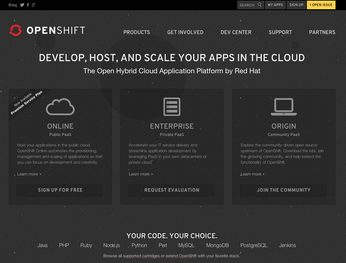Cloud computing with OpenShift
OpenShift as a Run Time
In my experience, most people don't really like computers, or operating systems, or platforms, or software in general. People like getting things done. People like things like a Rubik's Cube-solving LEGO robot [5].
Most interactions with OpenShift are via Git; you simply edit your local code repository, commit, and push to OpenShift (be it the service or your own instance). You can also use things like Jenkins, a continuous integration server that supports multiple languages. You commit a change, it builds and passes tests, and it gets committed to production. Or, you can provide your developers with an OpenShift instance and the cartridges you plan to use (SQL, NoSQL, etc.); then, they build something that works on those versions, and you can easily deploy it on your own servers.
The days of consultants delivering an application that only runs on some weird set of out-of-date libraries are past (I hope). Much like the Linux Standards Base (LSB), you can define a common set of software packages and versions that the application must support and run within. However, unlike the LSB, you can define it yourself and easily provide an example environment to your developers.
Conclusion
As with any technology, you began by walking, then running, then driving cars, then adding seat belts and airbags and comfortable seats. PaaS is potentially a very easy-to-use technology that provides you control over your environment but is offset by the actual availability of the PaaS software and environment.
I love using online *aaS providers like AWS and OpenShift Online – things just work. Scaling is literally not my problem, and backups are as easy as hitting the "make AMI image" button or typing git clone <example>. In fact, scaling can be as easy as doing nothing and letting the PaaS layer take care of it. As for deployment, OpenShift Origin has Puppet scripts, so you can drop OpenShift on top of your existing physical servers, your IaaS, or whatever, which, if you ask me, is a whole lot better than setting up physical servers.

Infos
- Extending OpenShift: https://www.openshift.com/developers/do-it-yourself
- OpenShift slides: http://www.slideshare.net/fallenpegasus/openshift-origin-build-a-paas-just-like-red-hats
- OpenShift Origin: http://openshift.github.io/
- MySQL password bypass: http://www.cve.mitre.org/cgi-bin/cvename.cgi?name=CVE-2012-2122
- Rubik's Cube Robot: http://www.youtube.com/watch?v=U58OEMnwfc8
« Previous 1 2
Buy this article as PDF
(incl. VAT)
Buy Linux Magazine
Subscribe to our Linux Newsletters
Find Linux and Open Source Jobs
Subscribe to our ADMIN Newsletters
Support Our Work
Linux Magazine content is made possible with support from readers like you. Please consider contributing when you’ve found an article to be beneficial.

News
-
Canonical Releases Ubuntu 24.04
After a brief pause because of the XZ vulnerability, Ubuntu 24.04 is now available for install.
-
Linux Servers Targeted by Akira Ransomware
A group of bad actors who have already extorted $42 million have their sights set on the Linux platform.
-
TUXEDO Computers Unveils Linux Laptop Featuring AMD Ryzen CPU
This latest release is the first laptop to include the new CPU from Ryzen and Linux preinstalled.
-
XZ Gets the All-Clear
The back door xz vulnerability has been officially reverted for Fedora 40 and versions 38 and 39 were never affected.
-
Canonical Collaborates with Qualcomm on New Venture
This new joint effort is geared toward bringing Ubuntu and Ubuntu Core to Qualcomm-powered devices.
-
Kodi 21.0 Open-Source Entertainment Hub Released
After a year of development, the award-winning Kodi cross-platform, media center software is now available with many new additions and improvements.
-
Linux Usage Increases in Two Key Areas
If market share is your thing, you'll be happy to know that Linux is on the rise in two areas that, if they keep climbing, could have serious meaning for Linux's future.
-
Vulnerability Discovered in xz Libraries
An urgent alert for Fedora 40 has been posted and users should pay attention.
-
Canonical Bumps LTS Support to 12 years
If you're worried that your Ubuntu LTS release won't be supported long enough to last, Canonical has a surprise for you in the form of 12 years of security coverage.
-
Fedora 40 Beta Released Soon
With the official release of Fedora 40 coming in April, it's almost time to download the beta and see what's new.

